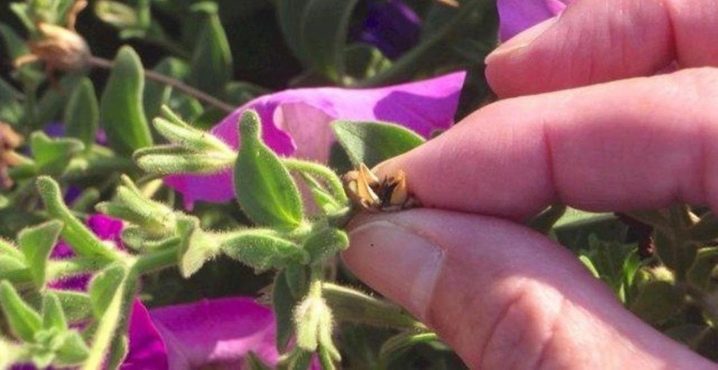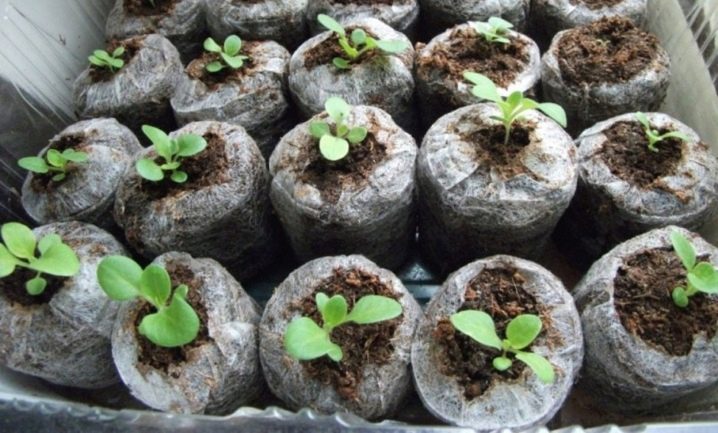Protection from diseases and pests
Cascading petunias, to the same extent as other varieties of this flower culture, are susceptible to various diseases and attack by harmful insects. Of course, unlike petunias grown in the open field, they are not threatened by parasites living in the soil, but there are enough other dangerous enemies. These include spider mites and aphids. In order to detect pests in time, you need to systematically examine the bushes of petunias. The first sign of the presence of aphids is the sticky traces of a whitish hue left by it on the surface of the leaves. It is not so easy to detect a spider mite, therefore, as a rule, a violation of vegetative processes and the loss of its attractive appearance by petunia bushes becomes evidence of its attack on a plant. As a preventive measure, cascading petunias can be treated with garlic infusion with the addition of dandelion. More radical measures include the use of insecticides "Confidor Extra" or "Aktara". As for diseases, the greatest danger to cascading petunias is represented by fungal diseases - for example, powdery mildew or late blight. Most often, the infected plant begins to lag behind in growth and development, blooms too late or does not bloom at all. Garlic infusion or fungicide preparations are suitable for treatment and prophylactic treatment.
Helps prevent fungal infections and nitrogen fertilization
As in the case of harmful insects, it is important to regularly examine petunias in order to notice signs of the disease in time. Deformed leaves, darkening of leaf plates, the appearance of plaque should be a cause for concern
It is much easier to prevent an infection than later trying to cure a diseased plant that is more likely to die.
Growing recommendations
Terry cascading petunias are most commonly grown from seed and thrive on nutritious soils. Very unpretentious in care. They are annual plants.
It is very important to prepare the substrate before planting, which can be purchased at any gardening store. Then it should be moistened and only then sow the seeds.
After that, they must be covered with glass or film for the fastest possible growth.
Before the seeds germinate, they should be regularly moistened and ventilated by opening the glass, it is also important to observe the temperature regime, which should be about +23 degrees. The first sprouts, with proper care, appear in 8-14 days.
The sprouts no longer need glass; before the main transplant into the ground, they must be placed in a bright place and do not forget to water.

Petunias are sown in different ways. Some in February, and some in March. Planting of finished seedlings of terry petunias is carried out in mid-May - early June. Depending on the variety, seed germination may vary.
It is important to feed the flowers regularly. This will allow them to bloom faster and longer.
Pinching can stimulate branching. As for watering already in the ground, it should not be too frequent, rather moderate. For regular flowering, faded buds should be removed so that flowering will be plentiful throughout the season.

Petunias are often grown in peat tablets and special cassettes as alternative cultivation options.

You will learn more about the rules for sowing terry petunias by watching the following video.
What is the difference from ampelous?
Cascading and ampelous petunias are different flowers, although the former are subspecies of the latter. Many growers ask a reasonable question, what are the main differences between these plants. Let's figure it out.
- Ampel petunia is characterized by the fact that it has fairly dense and stable shoots. In length, they often reach a mark of 2 m.Of course, it makes sense to count on such a result if you provide the plant with proper competent care.
- The stems of ampelous flowers are dense and strong. As they grow, they can "wrap" the supporting parts or actively grow along the ground, forming a beautiful ball. Just one petunia will be able to transform the flower garden you have formed into a spectacular flower "pillow". Its area may well reach 2 square meters. m. Of course, you need to properly care for the plant and water it on time if you want to achieve such results.
- The ampelous species is capable of creating a large number of large-sized flowers. That is why balconies and loggias, as well as decorative pavilions on personal plots, are so often decorated with such details.
As for the cascading petunia, here it should be noted that it is distinguished by beautiful flowing stems. Their length can only reach 1 m. This variety is decorated with bright and rich flowers of various sizes. They fall down in an original way, making the flower arrangement even more attractive. During vigorous flowering, cascading petunia looks very similar to spectacular flowering curtains.
Such plants are very fond of moisture and warmth, so caring for them is rather painstaking.
How to properly grow terry petunia
To get beautiful plants, you need to properly care for them. But first you need to correctly plant them.
Seed preparation
Seed germination is excellent. But terry representatives have few seeds. If you assemble it yourself, you will have to make a lot of effort. The peculiarity of self-collected planting material is that only 25% will inherit the parental genes. Therefore, flower growers are advised to purchase planting material in the store. Such seeds do not need special preparation.
Growing and caring for seedlings
The seeds are planted in specially prepared soil. Do it yourself in the fall. To do this, connect:
- 1 part of the sod layer of the earth;
- 1 part river sand.
They purchase ready-made soil in the store and disinfect it before planting by watering with potassium permanganate or heating in the oven.
Ready containers with earth are poured with a growth stimulant and the petunia seeds are carefully laid out. It is not necessary to fill up with soil, since the planting material is small. It is advisable to cover it with glass or polyethylene.
Landing in open ground
A cloudy day is chosen, so the flowers will better tolerate stress. The holes are prepared depending on the variety, the depth and distance between the bushes depend on the size of the plants. Then the bushes are carefully transferred, watered, and a shelter is built near the roots. Mulch or cover the soil with plant residues.
Fertilizer and feeding
When growing terry petunias in the garden, it should be remembered that plants, in addition to watering, also require nutrients. Especially during the budding period, flowers need feeding with potassium content. It is advisable to feed petunia 2-3 times a month. They use not only potassium fertilizers, plants respond positively to organic matter and complex mineral compositions.
Proper watering
It is advisable to do this regularly. Plants are watered in the morning and in the evening, but not poured, as the root system will begin to rot. Provide water regularly and in moderation.
Post-flowering care, pruning
To maintain flowering, you should promptly remove those specimens that have faded. This gives the plant more freedom to form new butters and bloom. Trimming the tops stimulates the formation of additional lateral branches with flowers.


